CMOS Synthesizers
Building Tone Generators from CMOS Logic

In the DIY synthesizer world, folks tinker with lowly CMOS logic chips to create everything from oscillators to sequencers. CMOS (Complimentary Metal Oxide Semiconductor) chips were an advancement in logic chips that eliminated most of the drawbacks of older TTL (Transistor Transistor Logic) parts.
CMOS chips are inexpensive, easy to find, and easy to use. This article presents a butt-load of CMOS sound generation circuits for your amusement.
What do CMOS Synthesizers Sound Like?
In their simplest form, these circuits generate digital squarewave sounds. They are not hi-fi and generally lack amenities like envelopes. However, by combining various CMOS oscillators, with a few other logic tricks, you can create complex waveforms that are decidely lofi, grungy, and drone like.
Chip Basics
For our experiments, we'll use a couple basic chips:
- 40106 Hex Inverting Schmitt Trigger:This chip contains 6 individual Schmitt triggers. A Schmitt trigger is a comparator circuit that incorporates positive feedback. What this means is that when a high signal (positive voltage defined as '1') is applied to the input pin, the output pin generates a low signal (ground voltage defined as '0). This simple circuit can be connected to a resistor/capacitor pair to rapidly turn on an off. When the frequency of this on/off conversion is in the audible range, we hear a square-wave tone.
- 4040 Binary Counter/Divider: This simple logic chip takes an input square wave and generates oscillations at 8 outputs with a frequency related to the input frequency. Q1 generates a frequency one quarter of the frequency of the input square wave, Q2 genertes an eigth, and so on through Q12. This allows us to harness octaves of frequencies.
- 4051 Eight Channel Analog Multiplexor/Demultiplexor: The voltage status of the three address pins A, B and C determines which of the eight channels presents its voltage to the common connection pin.

Note: All schematics on this site use the following notation for potentiometer tapers: A = Logarithmic, B = Linear
Experiment 1: An Astable Multivibrator
What the hell is an astable multivibrator? It is simply an oscillator that we will tune to put out a tone in a given range. Apply 5-9 volts DC to pin 14, connect pin 7 to ground. Then connect a capacitor and potentiometer as shown in the schematic. The values of the capacitor and potentiometer determine the frequency range--I chose values that give a good range within audible frequencies. The B10K pot adjusts the frequency.
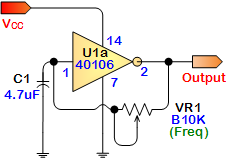
Experiment 2: Line Out Signal and Volume Control
This version adds a decoupling capacitor C2, a voltage divider (R1+R2) and a volume control. This tames down the output to a level more appropriate for hooking up to line-level inputs, such as an audio amplifier.
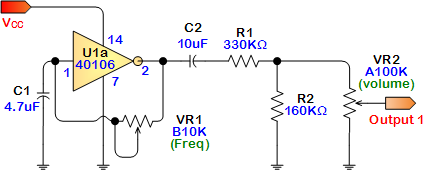
Experiment 3: Simple Low Frequency Oscillator (LFO)
Here's a simple LFO that can be used to drive other circuits such as modulation effects.

Experiment 4: Simple LFO with LED Rate Indicator
Here we add an NPN switching transistor, C2 as a decoupling cap, Diode D1, an LED and a current limiting resistor (R1) to provide a visual indication of the LFO operation.
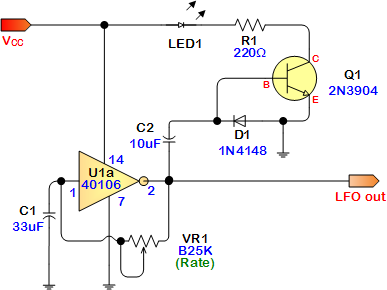
Experiment 5: Oscillator with Adjustable Duty Cycle
This modification of the Simple Oscillator adds an additional pot and diode to control the Duty Cycle, or the amount of time spent outputing one side of the square wave. The result is more interesting variation in the tone of the output.
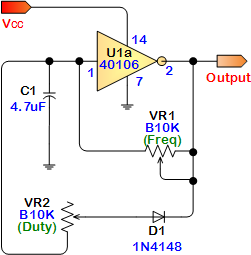
Experiment 6: Dual Oscillator
Here we take the output of one oscillator and feed it into the input of the second oscillator. Diode D1 keeps oscillator two from feeding back into oscillator one.
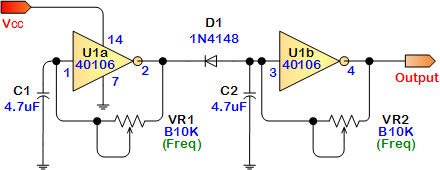
Experiment 7: Mixing with Diodes
Here we take the output of two independent oscillators and mix them together.
If you simply connect both outputs together, you will cancel the sound. This is because the output of each oscillator will feed back into the input, thereby creating chaos and other non-functional behavior. To solve this, you need to isolate the output signal from the input signal.
This can be done with a resistive mixer (simply put two resistors, 33kohms should work, at the outputs), or use diode mixing as shown here.
Resistive mixing will simply attenuate the sound but will not change its character. Diode mixing acts as a half-wave rectifier and creates a very interesting variation on the standard square wave sound.
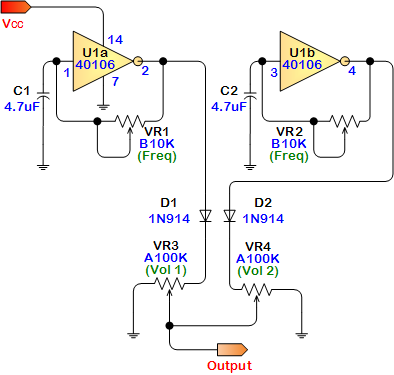
Let's Build Something Fun
In our first experiment with a flexible tone generator, let's look at the Heterodyne Space Explorer. This design is comprised of four 40106 square wave oscillators. The supply voltage can be sagged using VR1 to create starved sounds as each oscillator competes for voltage. Each output stage goes to a switch that flips between a resistor mixer and a diode mixer. Each sounds different. Each stage also has its own volume knob--this makes it easy to create beating heterodyning noise walls.
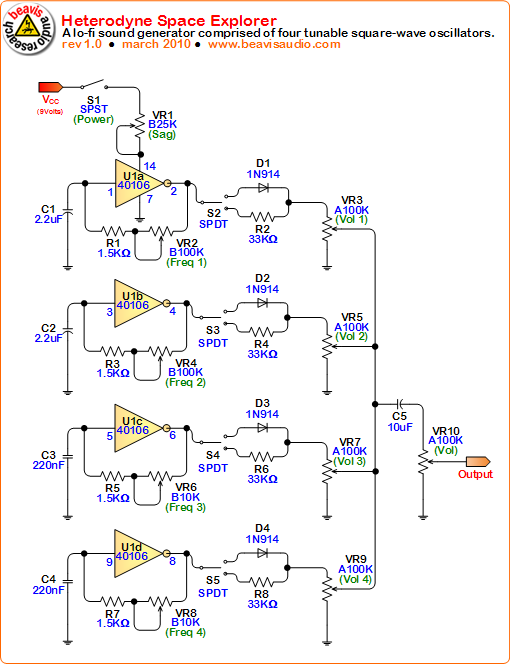
More Fun: Heterodyne Peyote Space Explorer
This piece is a conglomeration of various things: three independent oscillators, a complex waveform generator, a white noise circuit and a mixer. The complex waveform generator circuit from the excellent "Fun with Sea Moss" article. Sea Moss. Get it?

Using Your Effects!
You can take the output of your CMOS sound generator circuits and feed them into your effects and pedals. This opens up an entire new set of sounds. Fuzz, distortion, delay, phasing, chorus, all will allow you to create some very strange, good, or atmospheric sounds.
If you have a multiple oscillator circuit like the Heterodyne Space Explorer shown above, the application of a delay pedal analog or digital) to the output circuit will remove the two-dimensional nature of the sound and open it up dramatically. Reverb can also have a big impact on the spatial spread of the sound.
References and Further Reading
Flux Monkey's Excellent Looney Board: http://www.fluxmonkey.com/electronoize/looney1.htm
Art Harrison's Beautifully Chaotic Cacophonator: http://theremin.us/Circuit_Library/cacophonator.html
Fun with Sea Moss - http://www.milkcrate.com.au/_other/sea-moss/
Nicholas Collins, Handmade Electronic Music - http://www.nicolascollins.com/read.htm
Lunettas, circuits inspired by Stanley Lunetta - http://electro-music.com/forum/forum-160.html
